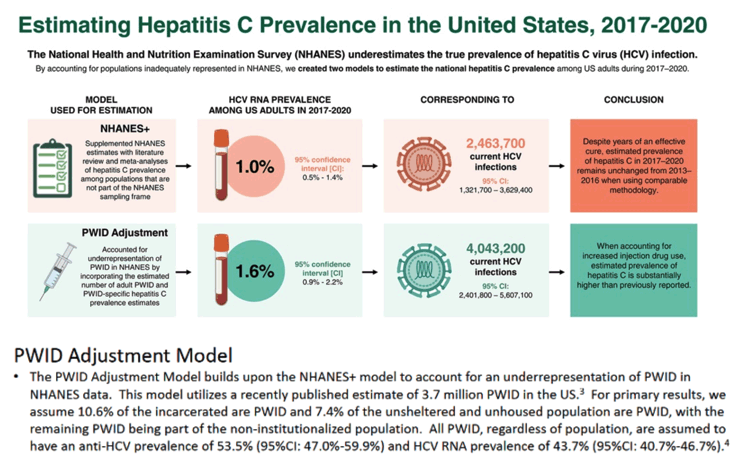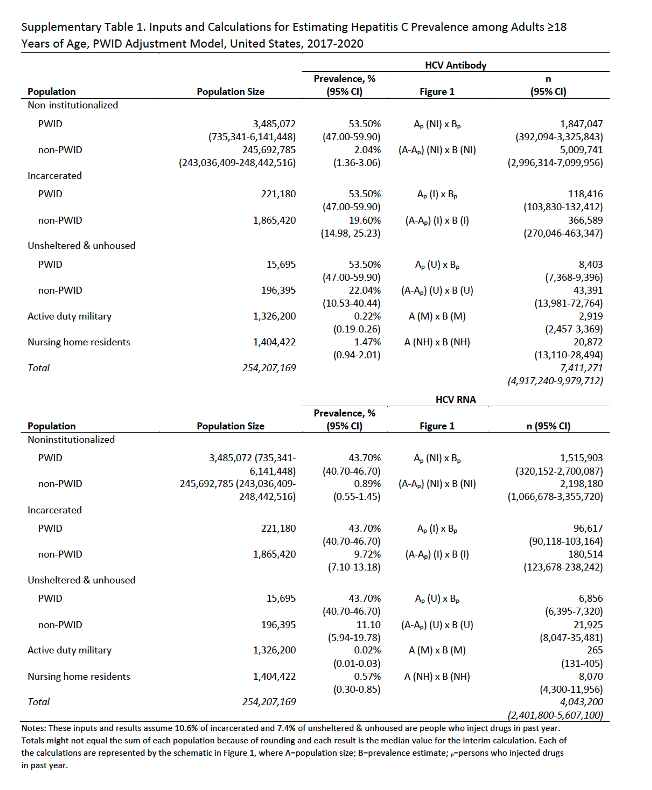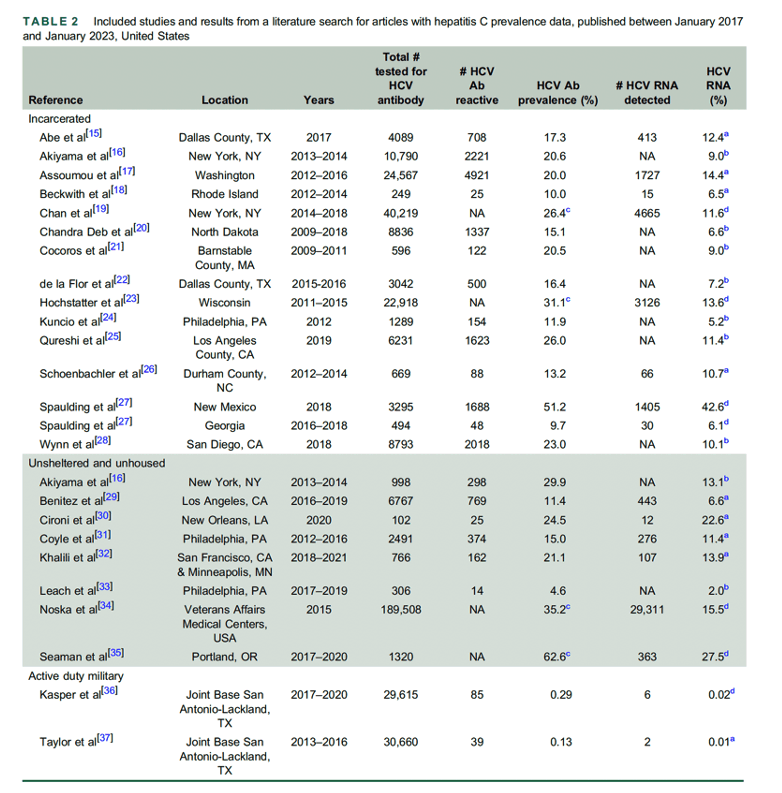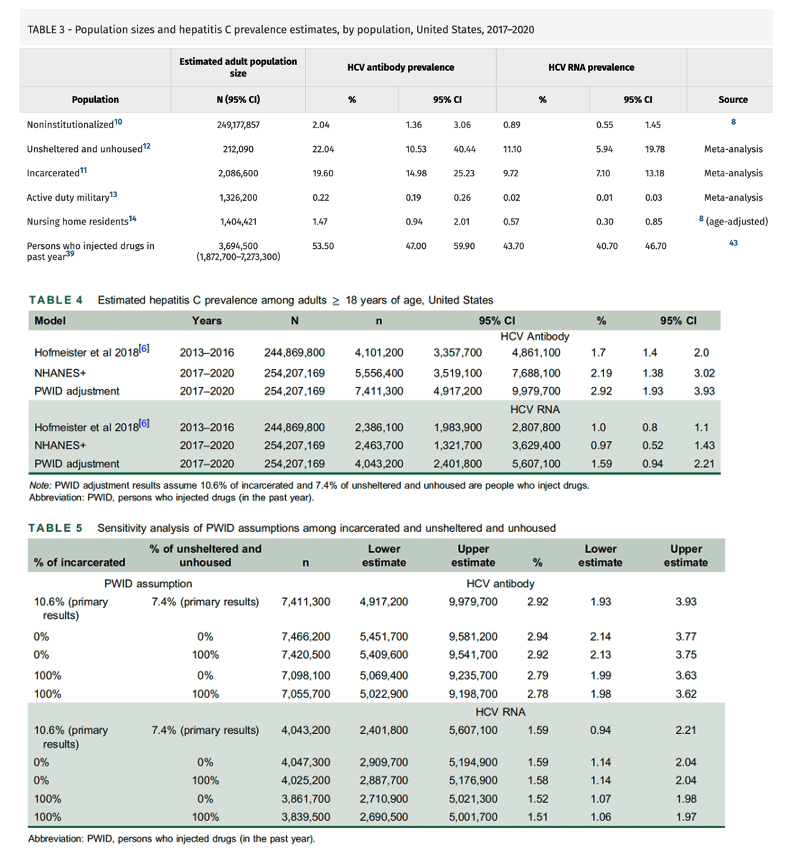| |
Estimating hepatitis C prevalence in the United States,
2017-2020 - see below, adj. PWD Model 4 million
|
| |
| |
Download the PDF here
Download the PDF here
Teshale et al estimated that 1.2 million people were treated for hepatitis C in the United States during 2014 to 2020.44 Combined, the trends in HCV antibody and HCV RNA prevalence indicate that although more than 1 million people have been treated for hepatitis C, diagnosis, linkage to care, and treatment are not occurring at a rate sufficient to offset the increase of new HCV infections
Using the PWID adjustment model, we estimated HCV RNA prevalence of 1.6% (95% CI: 0.9%-2.2%), corresponding to 4,043,200 (95% CI: 2,401,800-5,607,100) current HCV infections.
Reported at AASLD 2023 Nov.
Estimating Prevalence (over 4 million, up to 5.6 mill.) of
Hepatitis C Virus Infection in the United States, 2017-2020


Abstract
Background and Aims:
The National Health and Nutrition Examination Survey (NHANES) underestimates the true prevalence of HCV infection. By accounting for populations inadequately represented in NHANES, we created 2 models to estimate the national hepatitis C prevalence among US adults during 2017-2020.
Approach and Results:
The first approach (NHANES+) replicated previous methodology by supplementing hepatitis C prevalence estimates among the US noninstitutionalized civilian population with a literature review and meta-analysis of hepatitis C prevalence among populations not included in the NHANES sampling frame. In the second approach (persons who injected drugs [PWID] adjustment), we developed a model to account for the underrepresentation of PWID in NHANES by incorporating the estimated number of adult PWID in the United States and applying PWID-specific hepatitis C prevalence estimates. Using the NHANES+ model, we estimated HCV RNA prevalence of 1.0% (95% CI: 0.5%-1.4%) among US adults in 2017-2020, corresponding to 2,463,700 (95% CI: 1,321,700-3,629,400) current HCV infections. Using the PWID adjustment model, we estimated HCV RNA prevalence of 1.6% (95% CI: 0.9%-2.2%), corresponding to 4,043,200 (95% CI: 2,401,800-5,607,100) current HCV infections.
Abstract
Background and Aims:
The National Health and Nutrition Examination Survey (NHANES) underestimates the true prevalence of HCV infection. By accounting for populations inadequately represented in NHANES, we created 2 models to estimate the national hepatitis C prevalence among US adults during 2017-2020.
Approach and Results:
The first approach (NHANES+) replicated previous methodology by supplementing hepatitis C prevalence estimates among the US noninstitutionalized civilian population with a literature review and meta-analysis of hepatitis C prevalence among populations not included in the NHANES sampling frame. In the second approach (persons who injected drugs [PWID] adjustment), we developed a model to account for the underrepresentation of PWID in NHANES by incorporating the estimated number of adult PWID in the United States and applying PWID-specific hepatitis C prevalence estimates. Using the NHANES+ model, we estimated HCV RNA prevalence of 1.0% (95% CI: 0.5%-1.4%) among US adults in 2017-2020, corresponding to 2,463,700 (95% CI: 1,321,700-3,629,400) current HCV infections. Using the PWID adjustment model, we estimated HCV RNA prevalence of 1.6% (95% CI: 0.9%-2.2%), corresponding to 4,043,200 (95% CI: 2,401,800-5,607,100) current HCV infections.
Conclusions:
Despite years of an effective cure, the estimated prevalence of hepatitis C in 2017-2020 remains unchanged from 2013 to 2016 when using a comparable methodology. When accounting for increased injection drug use, the estimated prevalence of hepatitis C is substantially higher than previously reported. National action is urgently needed to expand testing, increase access to treatment, and improve surveillance, especially among medically underserved populations, to support hepatitis C elimination goals.
Despite years of an effective cure, the estimated prevalence of hepatitis C in 2017-2020 remains unchanged from 2013 to 2016 when using a comparable methodology. When accounting for increased injection drug use, the estimated prevalence of hepatitis C is substantially higher than previously reported. National action is urgently needed to expand testing, increase access to treatment, and improve surveillance, especially among medically underserved populations, to support hepatitis C elimination goals.


| |
| |
| |
|
|
|